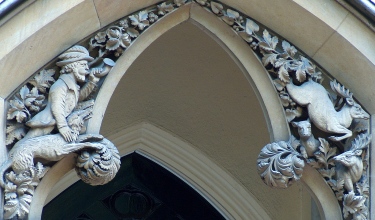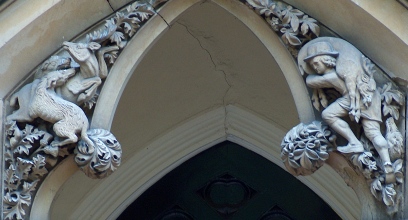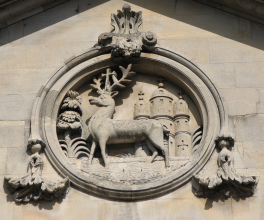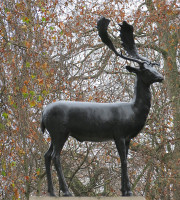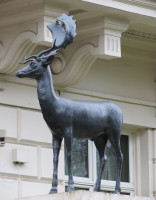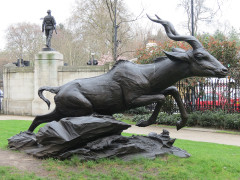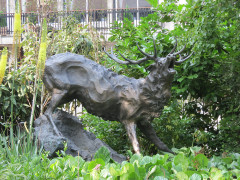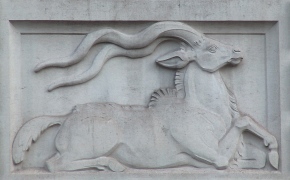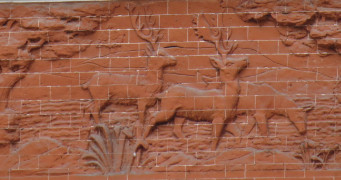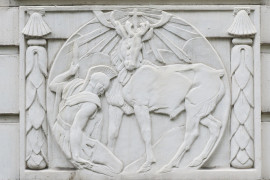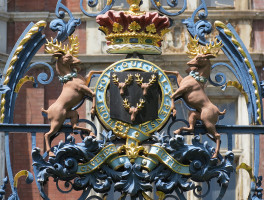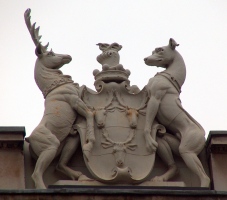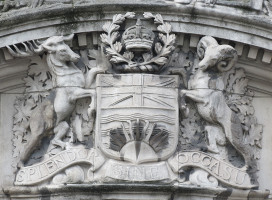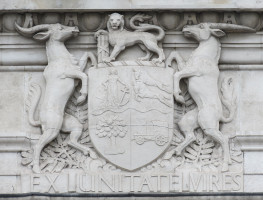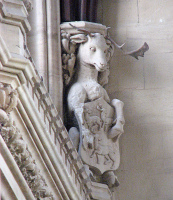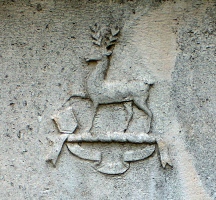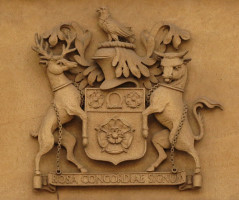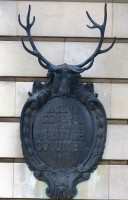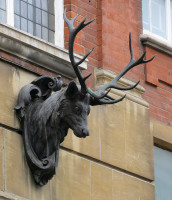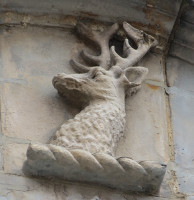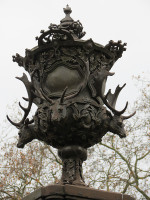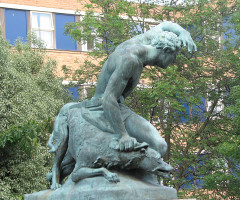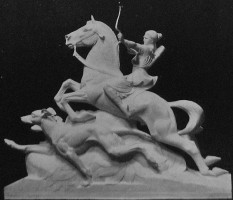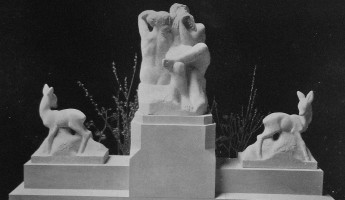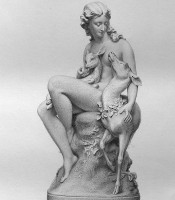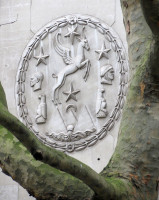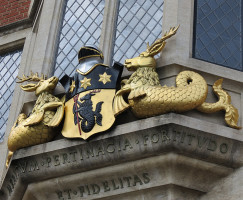Stag Sculpture and Deer Sculpture
Statues of stags and deer in Britain are fairly widespread, reflecting that they are native to the country, and evoke ideas of nobility and strength and speed, so are suitable for heraldry.
The most celebrated statue of a stag is probably The Stag of Hertford, a splendidly large bronze by Alfred Drury which is part of a World War I memorial. The neck is long, gracefully curved, and there is something of a mane to the chest. The antlers curve wide and back. More pictures of this work on this page.
Alfred Drury's sculpture of a Stag at Hertford. 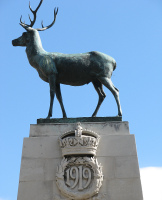
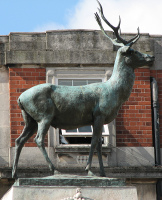
Of almost equal excellence are the pair of stags on the south side of Hyde Park, marking one of the entrances that is to the north of Knightsbridge. Here the head and neck is even more erect, the beasts having an alert look, yet despite the wide, flattened antlers, we have a sense of younger animals than the Hertford stag, for there is a lightness to the bodies and less muscle to neck and upper leg.
Hyde Park Stags.
There are a couple of particularly large modern examples of deer in London too. In Grosvenor Gardens near Victoria Station is Jonathan Kenworthy’s Lioness and Lesser Kudu, of prodigious size, showing the statue of the Kudu fleeing full pelt, its front legs both raised, and its long neck stretched forward. The lioness, just behind, is not shown in this view. In St James Square is a 1991 Stag by the sculptor Marcus Cornish, standing on a rock, mouth open in soundless bellowing, recalling in mood the famous Landseer picture of The Stag at Bay.
Modern large deer sculpture, by John Kenworthy and Marcus Cornish.
Considering relief sculpture of stags, another Kudu is to be found on South Africa House in Trafalgar Square. Nicely composed, the seated beast fills its frame, the heaviness of the curvy horns filling the upper space and providing almost equal compositional weight to the lower relief body. Below centre is a pastoral scene in brick with three deer sculpted in low relief, two stags and one doe. And below right, a rather grand religious stag, with a crucifix on its head emitting a burst of light, and a kneeling Greek warrior. 1930s work presumably. At the top of this page is a roundel with a rather poorly modelled but certainly spirited stag, once more with a crucifix on its head, standing in front of a Crusader Castle shown in low relief in the background. The composition is clever – with the plant to the left and the few leaves elsewhere, we see a whole scene encompassed in this little sculpture, and in the sparing use of features to indicate a whole story in this way, it evokes the woodcuts of Bewick.
Stag and Deer sculpture in low relief.
Now to heraldic stags. There are many of these on coats of arms, and here, below left, is a rather excellent Royal one, from one of the gates to Green Park, with a pair of stags rearing up, and holding a central roundel which itself bears three more stag’s heads. Wrought iron presumably, unless they be in bronze again. Though rather small, an impression of mass is given by the solidity of the chest and muscle of thigh and neck. Below centre is a freestanding heraldic group of stag and dog, with a central cartouche, again bearing the three stag’s heads. A most satisfying S-shaped curve to the head, neck and forward-arched back, nicely echoed by the dog on the other side. Below right we have a stag with a particularly large number of spines to his antler, and a mouflon as the other beast holding the central shield. This is on British Columbia House in Lower Regent Street just off Waterloo Place in London.
Heraldic stag sculpture
A couple more heraldic examples. First, a high relief coat of arms with two types of African deer as the supporters, one with straight horns, the other wickedly curved. This is back at South Africa House again. Then a sculpture in the round, with a single stag, one horn broken unfortunately, clutching a shield in front of him, which bears three deer in relief. Then a small heraldic stag in low relief from a monument, one forefoot raised and atop a small coat of arms. And to the right, matched with a rampant bull, is a stag wearing a long chain wound about his body.
Sculptures of stag heads are not infrequent, and can act as architectural trophies, as in the example below left, which seems all antlers, in bronze above a cartouche – this one on British Columbia House again. Then a much heavier beast, again in bronze, with a highly worked surface to emphasise the ruggedness and wooliness of the animal. Next is a high relief stag’s head in soft stone, underneath a curved pediment in an architectural setting. And then a fantastic pot of different types of stags’ heads, on the Coalbrookdale Gates in Hyde Park, near to the Albert Memorial.
Stag head sculpture.
These stag’s heads, like trophies, recall the hunt, and hunting stags is also a subject for sculpture. Below are a pair of Victorian Gothic doors, with highly detailed sculpture of such a hunt. On the left, a huntsman and his two hounds sight their quarry, he sounds his hunting horn, and the two stags and a doe on the other side of the door start and dash away in confusion. The second door shows the hounds biting at a hind, and a youth carrying a dead stag over his shoulder, while another grinning hound looks on.
The statue below left, is a well-known group called The Deer Stalker, by E. B. Stephens,
to be found in Exeter. We have the Classical hunter, holding his dog in check with one hand, while he shades his eyes
to gaze towards the deer we cannot see. The harmonious group to the right is called The Deer Hunting,
and shows a slender girl in the act of firing her bow from on horseback, the suppleness of her back,
the leap of the horse and the wavy body of the running greyhound echoing each other elegantly.
F. M. Taubman was the sculptor.
The Deer Stalker, and the Deer Hunting.
We have not shown a sculpture of a fawn yet, fairly unusual, but here on the left are two on an idyllic and ornamental piece
of architecture. There is a overly-sweet sculptural group called The Fawn shown below right,
showing some nude forest nymph, cradling a young fawn against her breast, its mother nestling against her side
and looking trustingly up at her. C. B. Birch was the sculptor.
The fawn in sculpture.
Finally, we should note that the deer can be combined with features of other animals to make a mythical beast too.
Below left we have a roundel glimpsed on the side of a building between the forks of a tree showing a winged deer sculpted
in low relief, in some zodiacal symbol. Slender and elegant, an exotic and magical beast.
Much more solid are the water or mer-stags, the deer equivalent of the hippogriff, supporting this shield of arms,
which itself has a low relief of a similar creature upon it, holding a trident.
Visits to this page from 19 Apr 2014: 8,654
